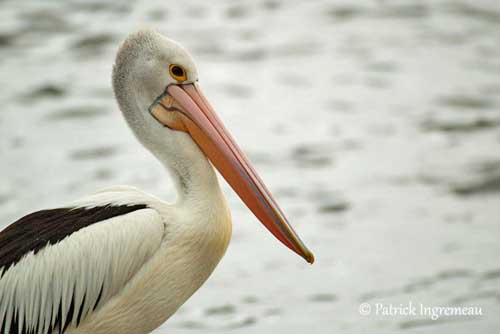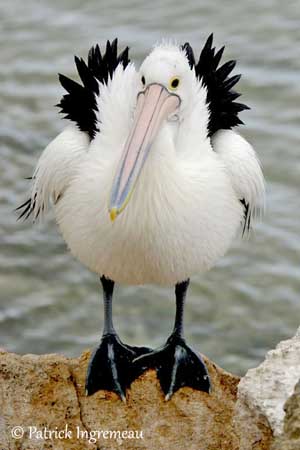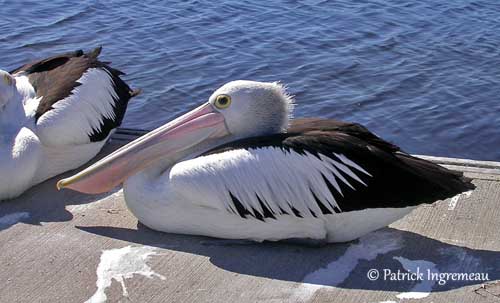
Fr: Pélican à lunettes
All : Brillenpelikan
Esp : Pelícano Australiano
Ital : Pellicano australiano
Nd : Brilpelikaan
Sd : Australisk pelikan
Photographer :
Patrick Ingremeau
TAMANDUA
Text by Nicole Bouglouan
Sources :
HANDBOOK OF THE BIRDS OF THE WORLD vol 1 by Josep del Hoyo-Andrew Elliot-Jordi Sargatal - Lynx Edicions - ISBN: 8487334105
BIRDS OF AUSTRALIA by Peter Rowland – Ed: Louise Egerton - ISBN: 1864363436
L’ENCYCLOPEDIE MONDIALE DES OISEAUX - Dr Christopher M. Perrins - BORDAS - ISBN: 2040185607
BirdLife International (BirdLife International)
Birds in backyards (Birds Australia and Australian Museum)
Wikipedia, the free encyclopaedia
Australian Pelican
Pelecanus conspicillatus
Pelecaniforme Order – Pelecanidae Family
BIOMETRICS:
Length: 152-188 cm
Wingspan: 230-260 cm
Weight: 4-6, 8 kg
DESCRIPTION:
The Australian Pelican is a gregarious species often seen feeding, roosting and breeding in large flocks.
The adult has black and white plumage. The upperparts are white with conspicuous black V ending on the rump into a point. The tail is black with white uppertail-coverts. On the black upperwing, we can see a white panel on coverts.
The underparts are white, except the blackish flights feathers, a black line across the coverts, and the black leading edge and tail.
On the white head, we can see a short greyish crest on the hindcrown, and the hindneck is greyish too whereas the foreneck is white.
The large bill is about 410/500 mm in male. It is pale pink to pale yellow with pinkish gular pouch. The tip is pale blue bordered yellow. There is a slight yellow hook at the tip, and both mandibles are serrated to hold the fish firmly.
The bare skin of the eye-ring is yellow and the eyes are dark brown. The short legs and the webbed feet are blackish.
During the courtship displays, the eye-ring and a distal quarter of bill become orange, while the gular pouch becomes dark blue, pink and scarlet.

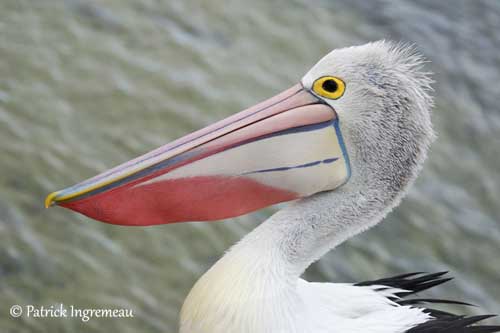
The female has similar plumage, but she is smaller with shorter bill (345/408 mm).
The juvenile resembles adults, but the black feathers are rather brown, and the wings show a reduced white patch.
VOICE: SOUNDS BY XENO-CANTO
The Australian Pelican, like the other species of this family, is silent away from the breeding colonies. It cannot produce vocal sounds, due to the absence of syrinx and associated muscles, but some other sounds can be heard.
They are able to produce yelps, screams, chattering, barking, grunting and bill-clapping.
The young birds make higher-pitched sounds audible above the deep noise produced by the adults.

IMMATURE
Brown and white plumage
and duller bare parts.
HABITAT:
The Australian Pelican frequents inland and coastal wide open water where there is not dense aquatic vegetation. It is usually found on large lakes (fresh or salt), reservoirs, rivers, estuaries, swamps, flooded areas in more arid regions, coastal lagoons…
It breeds on small islands or along the shores where the food resources are available.
They roost in large flocks in similar sites, and usually in wet areas.
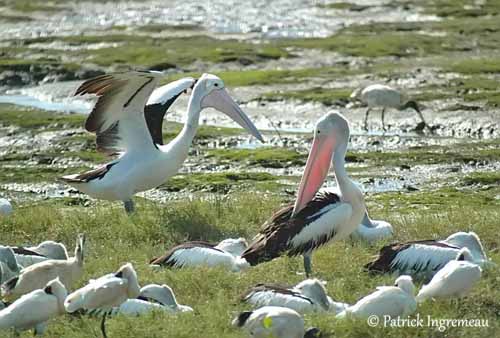
RANGE:
The Australian Pelican is found in most part of Australia and in Tasmania. This species occurs in New Guinea as non-breeding visitor.
They may perform occasional movements during the drought to find suitable water or breeding areas, travelling over long distances in flocks or family groups.
BEHAVIOUR:
The Australian Pelican feeds primarily on fish, but some other preys such as insects, small crustaceans, occasionally birds, reptiles, amphibians and probably small mammals are taken.
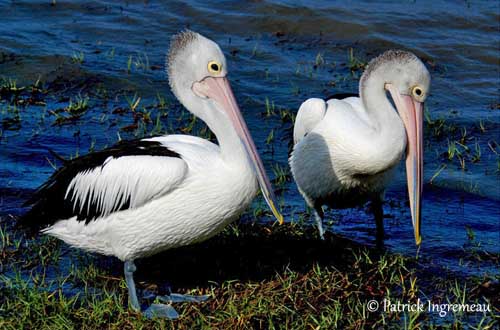
They feed in groups, in order to lead the fish into a central position. They capture the prey while plunging the large open bill into the water. Then, the bill is pushed against the chest to squeeze out the water, and the fish remains in the gular pouch. The fish is manipulated in the pouch to turn it head first, and the prey is swallowed with a jerk of the head.
The Australian Pelican also feeds solitary, and occasionally steals the food from cormorants.
This pelican is able to perform plunge-diving close to the water surface.
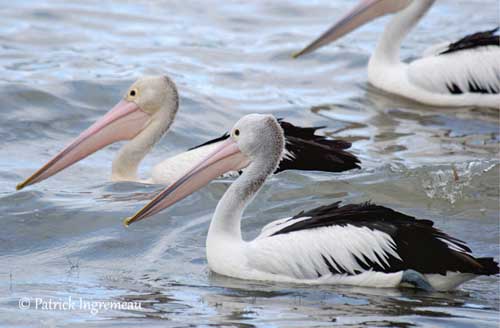
The adult males display together. They perform ritual displays with head shaking, accompanied by bill-clapping. During the courtship dance, they compete for one female. And finally, when a male is chosen by this female, she leads it to the nest-site. The copulation occurs there and they display again after mating.
During these displays, the colours of bill, eye-ring and gular pouch become brighter.
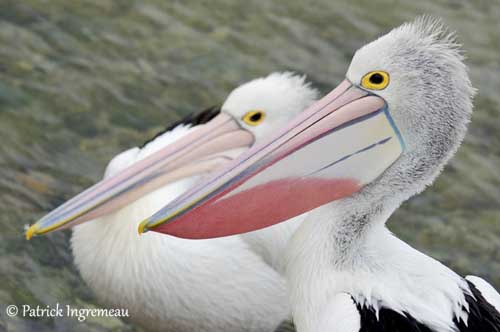
FLIGHT:
The Australian Pelican takes off by running over the water while flapping its large wings. It relies on thermal currents and soars high in the air, and over long distances. It lands on water by spreading out the wings to stop the speed.
When they fly in flocks, they often travel in V formation.

REPRODUCTION:
The Australian Pelican breeds almost all year round according to weather conditions such as rainfall and water levels.
The nest, placed on the ground, is a scrape dug by the female with bill and feet. It is made with twigs, grass, feathers and debris.
She lays 1-3 eggs some days later. Incubation by both parents lasts 32-35 days. At hatching, the chicks are blind and naked. They feed the regurgitated food by pushing the bill down to the adult’s gullet. Sometimes, the first hatched chick attacks the others or kills them.
They leave the nest at one month old, and gather at crèches with other young birds. They still depend on parents for 2-3 months, until they are able to fly and to feed alone.
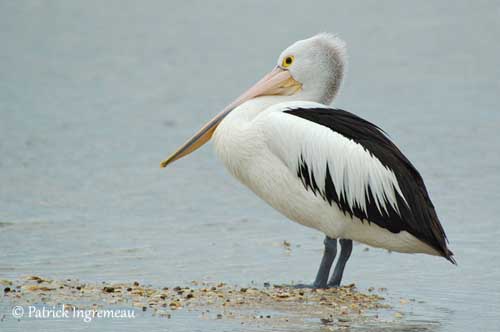
DIET:
The Australian Pelican feeds mainly on fish and some other aquatic preys such as shrimps and freshwater crayfish, but also insects, birds, reptiles, amphibians and occasionally small mammals.
They fish co-operatively and sometimes solitary.
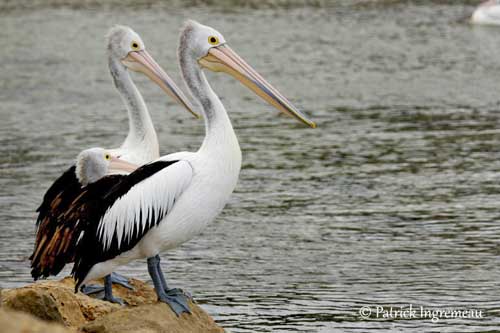
PROTECTION / THREATS / STATUS:
The Australian Pelican’s populations appear generally stable, and this species is common in suitable habitat.
However, they are threatened by the fishing hooks which sometimes tear the gular pouch. The changes in water levels are cause of breeding failure.
But currently, this species is not globally threatened.
